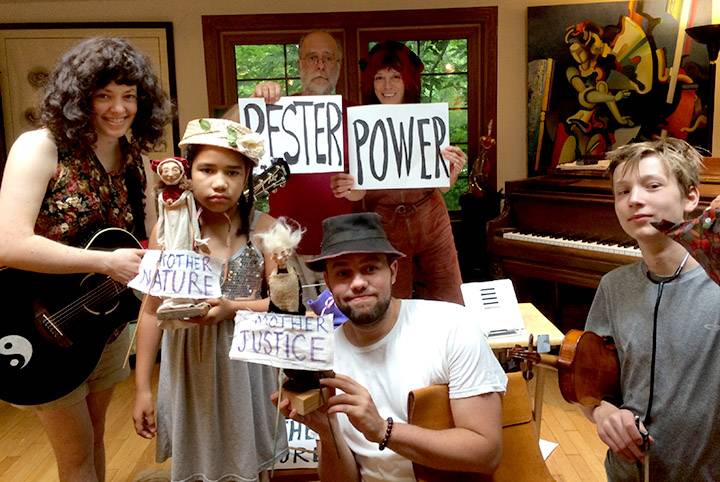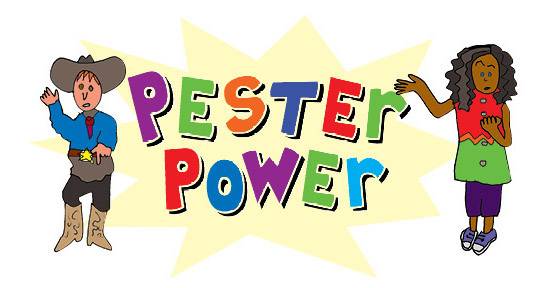What does it take to inspire people to Do Something about global warming in Urbana, Illinois?
You can find out this Saturday at 10:30 at the Urbana Farmer’s Market. And at the same time you can make your household part of an energized and empowered Climate Action Team.
Here’s how one dynamite project has gotten its spark. The players so far:
- one determined 10-year-old fresh from a school project
- one seasoned activist who put her in front of the Urbana Sustainability Advisory Commission
- one playwright intent on making climate crisis front-and-center in public thinking
- one environmental sustainability manager ready to put serious clout behind grass roots projects
Put them all together and you’ve got Pester Power!
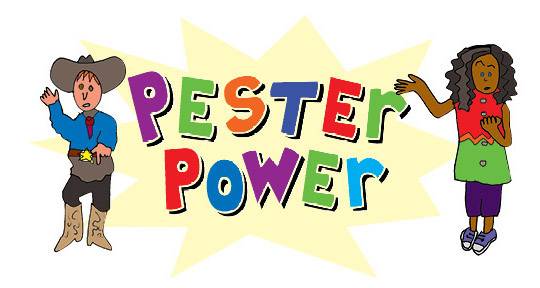
In 2014, Saba M-T was deep in in a school assignment that got her seriously worried about her future if we don’t put the brakes on global warming. Poking around the internet, she discovered a competition to get cities rallied around reducing the carbon impact of their individual households. Then, being a kid, she figured she didn’t have a chance to be taken seriously. So she went to her friend Danielle Chynoweth’s house one day and did what kids are so good at – Pester Power. Finally she got Danielle to take a break from cooking dinner and listen to her idea. They both realized the Georgetown University Energy Prize — $5 million for the winning community — is something Urbana might just pull off.
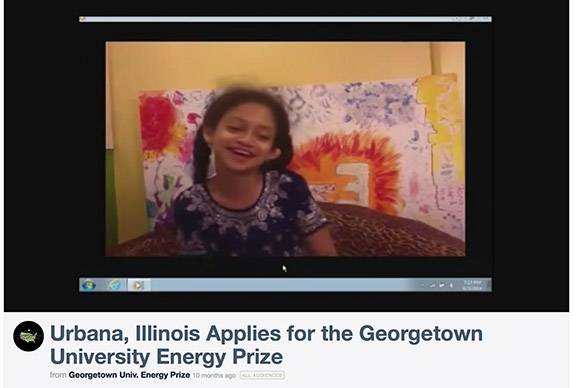 So Danielle called Marya Ryan and Todd Rusk, members of the Urbana Sustainability Advisory Commission, and got Saba on the June 2014 agenda. She would be out of town visiting her grandparents that night, so Danielle booted up her trusty Macbook and recorded Saba explaining the project.
So Danielle called Marya Ryan and Todd Rusk, members of the Urbana Sustainability Advisory Commission, and got Saba on the June 2014 agenda. She would be out of town visiting her grandparents that night, so Danielle booted up her trusty Macbook and recorded Saba explaining the project.
The commission liked what it saw. And Scott Tess, Urbana’s Environmental Sustainability Manager, went to work.
In December 2014, Susan Parenti wrote and produced a play for the fall session of the School for Designing a Society about kids pestering their parents to pay attention to two climates-in-crisis: the chaos of tornados, tsunamis, droughts and floods roiling out of global warming – and the local and national tragedies of America’s race war on itself. Parenti was struggling over the impact of local teen Kiwane Carrington’s killing at police hands in his own back yard. The nation was reeling after teen Trayvon Martin’s was shot in cold blood by a self-appointed vigilante. Parenti was mystified and frustrated at the silence in town about current and impending disasters. And she saw that the dilemma rests on our children as they grow up in the climates we’ve created. So she put them at center stage.
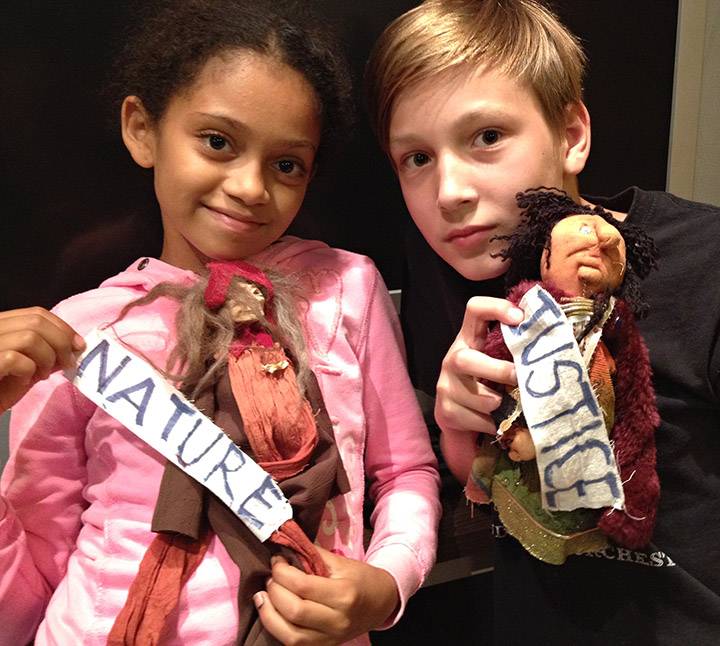
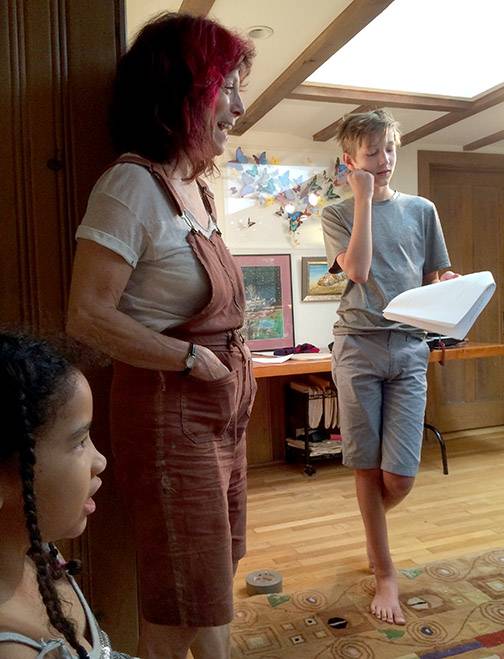
 Scott Tess arrived in Urbana in 2012 from Orlando, Florida with powerful credentials: one degree in environmental science from the U of I, a second in Urban Planning, and over seven years’ professional experience in environmental action and pollution in two Florida counties. He was ready to hit the ground running just as the City of Urbana drafted its first Climate Action Plan. He interfaces with the community through Urbana’s Sustainability Advisory Commission (Champaign people, take note! Champaign has a Sustainability Assessment from 2012 but no dedicated staff or commission to back it up).
Scott Tess arrived in Urbana in 2012 from Orlando, Florida with powerful credentials: one degree in environmental science from the U of I, a second in Urban Planning, and over seven years’ professional experience in environmental action and pollution in two Florida counties. He was ready to hit the ground running just as the City of Urbana drafted its first Climate Action Plan. He interfaces with the community through Urbana’s Sustainability Advisory Commission (Champaign people, take note! Champaign has a Sustainability Assessment from 2012 but no dedicated staff or commission to back it up).
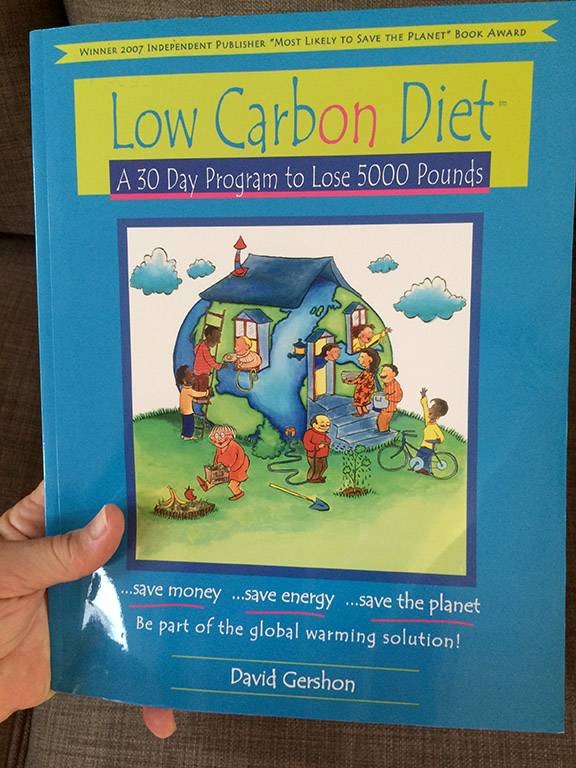
For Tess, it was clear that the single largest impact Urbana can have on total climate change is by reducing greenhouse gas emissions (that’s GHG for insiders). He had admired a workbook, Low Carbon Diet by David Gershon, awarded the book “Most Likely to Save the Planet” by independent publishers in 2007.
It spells out in clear and easy steps what every household can do to quantify and reduce its carbon impact in a 30-day program to lose 5,000 pounds. Link that to Pester Power to make grown-ups get their act together, and you have Climate Action Teams in the making. And that was the hook Tess needed to write a successful grant application.
The Georgetown University Energy Prize (GUEP) has rigorous requirements for measuring a community’s carbon footprint. As Tess worked through the application, he realized it requires aggregate data from the local power company to show overall energy use over the two years of the project. The community that makes the greatest reductions per capita wins $5 million.
In Urbana, that data would have to come from Ameren. And they weren’t answering Tess’s calls. As he scrambled to compile 43 pages of detailed information, the application deadline was looming. Silence from Ameren.
In desperation, Tess appealed to Georgetown to allow Urbana to submit the almost-complete proposal while he battled to get the energy data. Lo and behold, Georgetown itself made the trump call and appealed directly to Ameren. That was the final push that got them moving. Tess got his data. Ameren wrote a letter of support for the grant application (along with Mayor Prussing and many other organizations). And the application was complete.
The people at Georgetown were delighted with Urbana’s approach: putting kids in charge to get the community mobilized. And so Urbana joined the fifty other communities selected to participate in the two-year process. Here’s the spread of other participants. Want to visit Walla Walla and see how they’re doing?
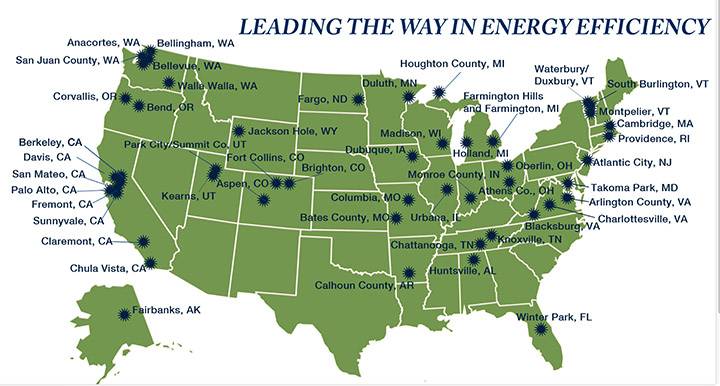
The big IF — will Urbana actually win $5 million? Tess and Pester Power have many dreams; here’s what they outlined in the proposal. With five million greenbacks, Urbana would immediately set up a 501(c)(3) to protect and increase the funds for long lasting programs. Then offer bigger and better incentives for households and businesses investing in energy efficiency. Train a core of facilitators to mobilize the entire community for every possible impact.
And what about racial climate? That’s in there too. You’ve probably seen the hot debates on the county board about whether we need a bigger better jail. The people now overfilling that county jail are disproportionately and unjustifiably African American. So in nation-wide efforts to reduce prison populations, the challenges are great. Urbana’s grant winnings would include ample funds for a job training program for re-entering citizens to learn the skills for retrofitting homes and commercial buildings for top energy efficiency. And Tess is the guy who knows precisely how to do that.
Bingo, both climate crises addressed.
Just how Georgetown came up with the idea for an energy prize is another intriguing strand in the story. In June 2013 President Obama spoke at Georgetown University about carbon emissions as the #1 concern for combatting climate change. Physicist Francis Slakey saw that as a challenge that his university was well equipped to tackle. He held an all-day brainstorming session with a savvy group of scientists and policy experts to figure out the best way to really convince the greatest number of people to Do Something.
The brainstormers agreed that the idea of a prize gets people going, especially one that comes with $5 million. They carefully looked at every aspect to give it the greatest impact. First: what communities are eligible? They chose populations between 5,000 and 250,000. These could be most accurately evaluated, there are almost 9,000 in that size range, and they make up 65% of the U.S. And the Georgetown experts appreciate just how resourceful and innovative American households can be — so let’s get them inspired and working. And so GUEP was born.
All across the globe, as Tess says, we need projects that can work in a “budget constrained environment.” Same for Georgetown. They want to identify the best and most varied ways to “stimulate efficiency, replicable best practices, and improved education.” And the grant requires that the $5 million must be spent on energy efficiency programs that “reward the community as a whole and provide for the long-term implementation of those plans.”
 What’s a sure-fire way to get people involved? Kids, creativity, city support, and lots of elbow grease. Pester Power! is going public at the Urbana Farmer’s Market at 10:30 a.m. this Saturday.
What’s a sure-fire way to get people involved? Kids, creativity, city support, and lots of elbow grease. Pester Power! is going public at the Urbana Farmer’s Market at 10:30 a.m. this Saturday.
Who is the last, critical player needed to win $5 million? Look in the mirror and ask yourself if you’re ready to save big bucks on your energy bills, have a good time with your neighbors, finally get around to all those insulating and home improvement tasks, and get a good laugh at our kids’ creativity and determination.
The Pester Power team will be at the farmer’s market every Saturday in July. They’re ready to brainstorm specific ways you can put your home on a low carbon diet. Together you can sit in the shade at their table, write your ideas on a postcard addressed to yourself, and they’ll mail it back to you with contacts and dates for climate action teams. The play will only be performed at the market this Saturday at 10:30 a.m., but there are more performances throughout the community this summer and into the fall. Ask Linda Turnbull or look here.

You don’t have to live in Urbana to be part of the action. Your Ameren data won’t be part of the GUEP proposal. But you can get experts on your team and watch your power bills go down. Here are some ideas from the Low Carbon Diet:
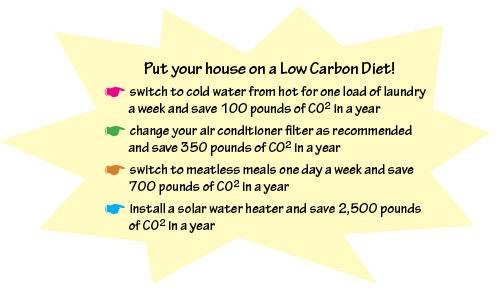
Use some lazy summer hours to slow down and figure out how to Stay Cool without blasting the air conditioning. Champaign-Urbana is the best place I know for brainstorming, networking, hanging out, and saving the planet.
Remember, you’ve got Pester Power!
